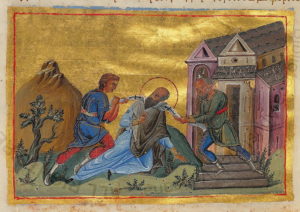St Paul of Constantinople
During the middle of the fourth century when the theological battle between the Arians (who believed that Christ was not divine) and the Trinitarians was at its height, choosing the correct side was often a matter of life or death. At this time, the Arians, with the support of the imperial family, were in the ascendant, and we can see in the career of St Paul of Constantinople that theology could be a blood sport.
St Paul was a native of Thessalonica, but from his boyhood he had been secretary to Bishop Alexander by whom he was afterwards promoted to be a deacon in the church of Constantinople. When the aged hierarch lay on his death-bed-apparently in the year 336 — he recommended St Paul as his successor and the electors endorsed his choice. Paul was accordingly consecrated by several orthodox bishops, and practically all that is known of himself and his life is the record of an episcopate made stormy by the heretical Arians, who had supported the candidature of an older deacon called Macedonius. At their instigation the Emperor Constantius summoned a council of Arian bishops, by whom Paul was deposed and banished. The vacant see was bestowed, not upon Macedonius, but upon the neighbouring metropolitan Eusebius of Nicomedia. St Paul took shelter in the west, and could not regain possession of the see until after the death of his powerful antagonist, which, however, took place soon afterwards. He was then reinstated amid popular rejoicings. The Arians, who still refused to acknowledge him, set up a rival bishop in the person of Macedonius, and soon the opposing factions came into open conflict and the city became a prey to violence and tumult. Constantius therefore ordered his general Hermogenes to eject Paul from Constantinople. But the populace, infuriated at the prospect of losing their bishop, set fire to the general’s house, killed him, and dragged his body through the streets. This outrage brought Constantius himself to Constantinople. He pardoned the people, but he sent St Paul into exile. On the other hand he refused to confirm the election of Macedonius which, like that of his rival, had taken place without the imperial sanction.
We find St Paul once more at Constantinople in 344, and Constantius then consented to re-establish him for fear of incurring the hostility of his brother Constans, who with Pope St Julius I supported Paul. But on the death of the Western emperor in 350 Constantius sent the praetorian prefect Philip to Constantinople with instructions to expel Paul and to instal Macedonius in his place. Too astute to risk incurring the fate of Hermogenes, Philip had recourse to a stratagem. He invited St Paul to meet him at the public baths of Zeuxippus and, whilst the people, suspicious of his designs, were gathered outside, he hustled Paul out of a side window and got him away by sea. The unfortunate bishop was exiled to Singara, in Mesopotamia, and from thence was removed to Emesa in Syria and finally to Cucusus in Armenia. There he was left for six days and nights without food in a gloomy dungeon, and then strangled. This, at any rate, was the account given by Philagrius, an official who was stationed at Cucusus at the time.
